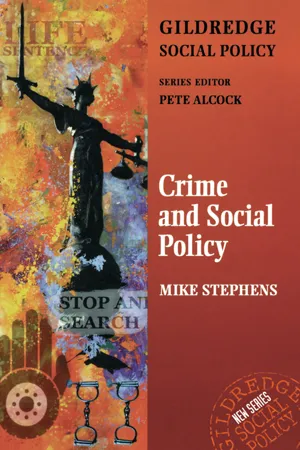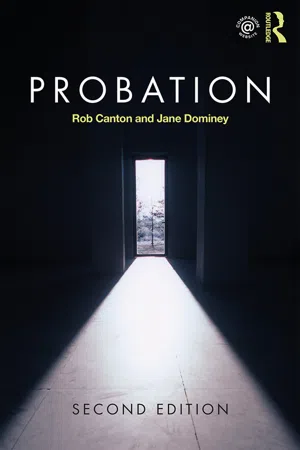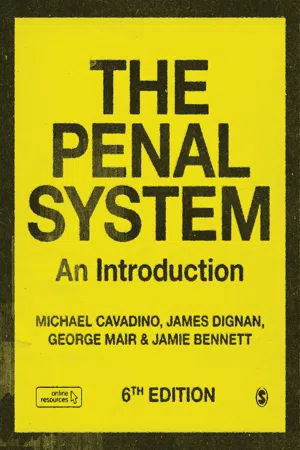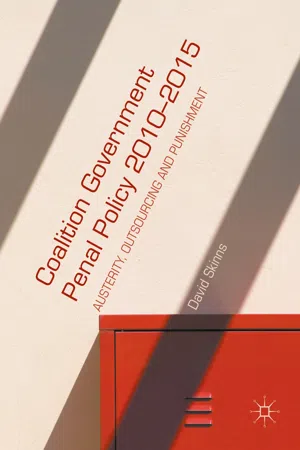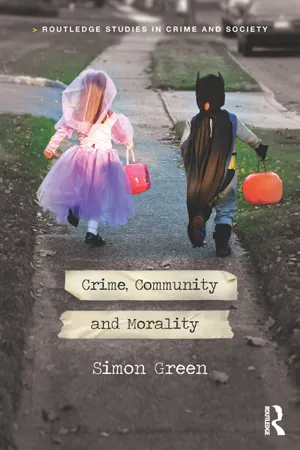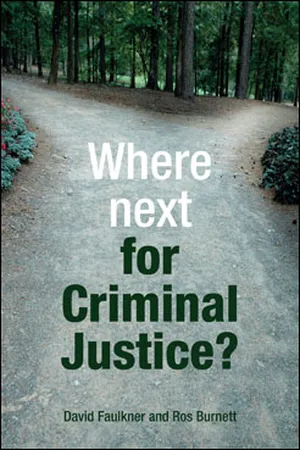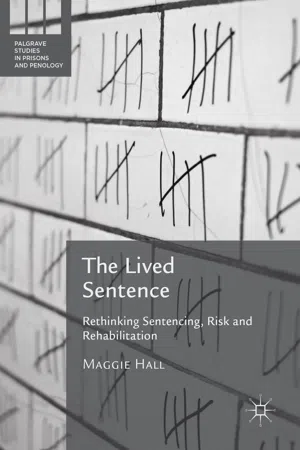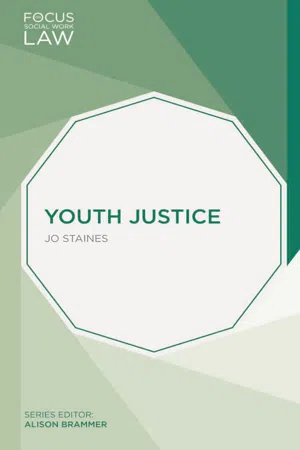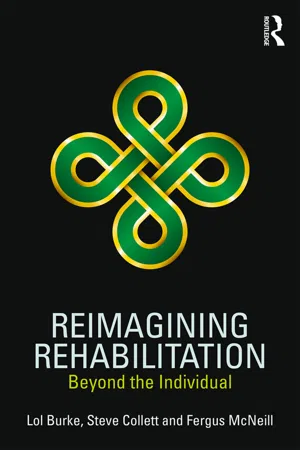Psychology
Community Sentencing
Community sentencing is a form of punishment that involves offenders serving their sentence within the community rather than in prison. It aims to rehabilitate the individual by providing access to support services and programs while maintaining a level of accountability. This approach is often used for non-violent offenders and can include measures such as community service, electronic monitoring, or treatment programs.
Written by Perlego with AI-assistance
Related key terms
12 Key excerpts on "Community Sentencing"
- eBook - ePub
- Dr Mike Stephens, Mike Stephens, Pete Alcock, Professor Peter Alcock (S Ed)(Authors)
- 2014(Publication Date)
- Routledge(Publisher)
Community sentences: from alternatives to imprisonment to punishment 8OutlineAN OVERVIEW OF COMMUNITY SENTENCESThe probation service began in the early twentieth century as an organization committed to advising, assisting and befriending offenders in the hope of rehabilitating them.The courts tend to look upon community sentences as soft options.Accordingly, community sentences have become more punitive in their content and the probation service itself has had to alter its strong adherence to a rehabilitative goal in favour of a tougher approach.Community sentences were first introduced in the early part of the twentieth century with the creation of the probation service. The probation order – the forerunner of the modern community sentence – was rooted, first, in a Christian tradition and, then, in a professional social work philosophy of wanting to help and improve one’s fellow man. Over the years, a number of other measures have been added to the range of community sentences, and the professional social work principles behind them have been modified. The social work ideas of rehabilitation originally at the heart of community sentences have now been severely curtailed. For example, the Criminal Justice Act 1991 provided a framework for inspection and set standards of practice to ensure that community sentences became effective punishments in their own right. This ‘punishment in the community’ approach recast community sentences in a more punitive fashion. It was felt that the public and sentencers would only accept community sentences if they shed their ‘soft’ image and were seen to become more demanding and ‘tougher’. However, whereas in recent years both the Magistrates’ and the Crown Courts have noticeably increased the proportions of those sentenced to imprisonment for indictable offences and have made less use of the fine, the use of community sentences has shown only a modest increase. In 1997, 118,000 people started a community sentence under a court order, which was a 2% increase on the 1996 figure of 115,000 (Sheriff 1998). - Tougher powers on breach, including a possibility of a term of imprisonment even when the original offence was not imprisonable (Sch. 8) Legal Aid, Sentencing and Punishment of Offenders Act 2012 Power for courts to suspend prison sentences of up to two years Criminal Justice and Courts Act 2013 All community orders must include a punitive element Offender Rehabilitation Act 2014 Extends supervision to all released prisoners, including the possibility of recall to prison for breach Introduces rehabilitation activity requirement (see following discussion)There are compelling arguments for trying to increase the use of community sentences, to improve their implementation and effectiveness and – just as importantly – to make this apparent to courts and to the public. However, there is little evidence of the capacity for community sentences on their own to have a discernible impact on the numbers of people in prison. This claim has gained further support from a recent study that found that across Europe community sanctions have ‘widened the net’, tending to supplement rather than reduce imprisonment (Aebi, Delgrande and Marguet 2015).Cohen (1985) argued that the relationship between prison and its supposed alternatives is more symbiotic than competitive: they work together to extend and disperse social control. While this thesis has had its critics (Bottoms 1983), it is still very difficult to point to contemporary examples of ‘alternatives’ leading directly to a reduction in a prison population. Even when replacing terms of imprisonment, community sentences typically displace (at best) those who would have served short terms of imprisonment and therefore tend to have no more than a modest effect on the prison population, which is influenced not only by the number of people sent there but, and perhaps more significantly, by the length of time for which they stay (Fitzmaurice and Pease 1986).Net-widening is one well-known hazard of non-custodial sanctions (Cohen 1985). These sentences may deflect some offenders from custody but draw in many more who might otherwise have been dealt with in less intrusive and cheaper ways. Over time, while probation may have worked with more serious offenders during and after periods of imprisonment, it has had to deal, on community sentences, with less
- eBook - ePub
The Penal System
An Introduction
- Michael Cavadino, James Dignan, George Mair, Jamie Bennett(Authors)
- 2019(Publication Date)
- SAGE Publications Ltd(Publisher)
The relative ‘effectiveness’ of penal sanctions (in terms of their success in reforming or individually deterring offenders) is conventionally measured by comparing reconviction rates, despite their well-known shortcomings as a measure of ‘penal success’ (see, for example, Brody, 1976; Maltz, 1984; Lloyd et al., 1994). When the reconviction rates that are associated with custody and community penalties are compared – after allowing for factors that are known to influence the risk of reconviction (such as age at first offence, type of offence, criminal history and gender) – the differences between them are usually found to be negligible. However, this may be because community penalties have not been living up to their potential. It has been claimed that community sentences which conform to certain principles – for example those focusing on social skills or utilising cognitive behavioural methods – can have measurable positive effects on recidivism, whereas those with strong punitive effects can increase recidivism by some 25 per cent (McGuire and Priestley, 1995). Research in Scotland has shown that offenders whose experience of community service is rewarding and worthwhile tend to have lower reconviction rates than those who find it unrewarding (McIvor, 1992); and it is worth thinking about this finding in the context of the increasingly punitive nature of Community Payback we have noted. Research evidence also seems to show that comparable reformative programmes are more likely to be successful in community settings rather than in custody (see, for example, Andrews et al., 1990; Lipsey, 1992; Vennard et al., 1997; Goldblatt and Lewis, 1998; Andrews, 2001).Moreover, there is no reason in principle why community penalties should not also serve denunciatory or retributive ends, just as custody is supposed to. (For example, community punishments of differing onerousness (or ‘penal weight’) can be prescribed for offences of differing seriousness.) Indeed, community-based restorative justice processes such as mediation and conferencing have the added advantage, if conducted properly, of denouncing an offender’s conduct without at the same time denigrating and stigmatizing the offender as a person, in the way that conventional penalties (and particularly custodial ones) do. As for the pursuit of other purposes such as reparation and reintegrative shaming (see Chapter 2 , section 2.4), it also seems highly probable that these are more likely to be successful where offenders are kept in the community, for fairly obvious reasons: it is hard to make amends to the community and become part of it again if you are locked away from it. This leaves, as the main apparent advantage that custody has over other penal measures, the ‘public protection’ it appears to offer by ‘incapacitating’ offenders from committing certain kinds of offences (see Chapter 2 - eBook - ePub
Coalition Government Penal Policy 2010–2015
Austerity, Outsourcing and Punishment
- David Skinns(Author)
- 2016(Publication Date)
- Palgrave Macmillan(Publisher)
There was no opposition—indeed, there was outright support—for providing resettlement services for all prisoners dealing with a variety of matters including employment, accommodation and income support as well as drug and alcohol dependency and mental health issues. However, there was considerable concern in official circles about doing this in the context of a 22 % increase in caseloads when there were significant reductions in MOJ budgets and a relatively poor existing infrastructure. Furthermore, the wisdom of tagging on to the clearly failing short prison sentences a lengthy period of licence supervision was questioned. Following this course meant building on failure and creating a situation which, given the chaotic lives of many repeat offenders, would almost certainly mean a high rate of breakdown and breach for non-compliance, resulting in recall to prison. Given the lower reconviction rates for community sentences (probably resulting from avoiding the worst negative consequences of imprisonment), the fact that they are cheaper than imprisonment and could offer a longer, more intensive intervention commensurate with the level of offence seriousness, it is hard to see how the more elegant solution—the use of community sentences more for non-violent offenders—was not taken up, with restrictions being placed on court use of short prison sentences. Following the Corston Report and its strictures concerning the use of prison sentences for non-violent women and the need for a non-custodial sentences to become the norm for such groups, this is especially so.‘Robust and Credible’ Community Sentences
An assessment is made here of the emergent rationale for and practice of community sentences, including community orders and financial penalties. The conclusion reached is that a clear gap between rhetoric and reality developed. Although rehabilitation, understood as little more than moral reform, was placed at the forefront of community sentences by the political rhetoric of the period, it remained at best a tertiary aim, with punishment being primary from the beginning. Punishment gained greater salience as time progressed, by means of further rhetorical gymnastics (punishment and rehabilitation being seen as inseparable) and, eventually, a blatant pragmatism concerning what is to be done with offenders as long as they do not reoffend, the outsourced providers complied with the court order and operated within the general punitive parameters set down by government. However, this did not mean that rehabilitation and reparation were totally neglected, although these aims became increasingly compromised by the growing emphasis on punishment. - eBook - ePub
- Simon Green(Author)
- 2014(Publication Date)
- Routledge(Publisher)
Punishment, Custody and the Community (Home Office 1988a) was the first indication of this renewed emphasis on punishment. This document was primarily concerned with alleviating prison overcrowding by increasing the role of community sanctions. What is noticeably different about this Green Paper is the emphasis on community sanctions being seen as a punishment and not a ‘soft option’:Community service should be rigorous and demanding, otherwise the sentencers and the general public will not accept it as punishment. The need for frequent and punctual reporting is part of the discipline imposed by the order. The work to be done should be useful and of benefit to the community; there is no reparation if the work itself is pointless. Ideally, the public should be able to see the results of the work and, in the process, the offender’s self-discipline and motivation should be improved.(Home Office 1988a, para. 2.5)The Government believes there is scope for reducing the use of imprisonment by introducing a form of punishment which leaves the offender in the community but has components which embody the three elements identified in Part I, punishment by some deprivation of liberty, action to reduce the risk of offending and recompense to the victim and the public.(Home Office, 1988a para.3.8)These two extracts clearly illustrate the emphasis on community punishment and also the concern that such punishments needed to be seen as effective and punitive by both the sentencers and the wider community. This would suggest that one of the aims of the government was to create a public perception of severity. The Green Paper also proposed a number of further restrictions on the liberty of offenders in the community. These included: introducing curfew powers, the extension of tracking offenders in the community by introducing electronic tagging, intermittent or weekend imprisonment and the court insistence that individuals perform certain activities in their free time (e.g. attending football matches or other sporting events). The other major inclusion within this Green Paper was a clear emphasis upon the economics of punishment. The paper made it very clear that financial considerations were paramount to the effective running of community sanctions: - eBook - ePub
- Faulkner, David, Burnett, Ros(Authors)
- 2011(Publication Date)
- Policy Press(Publisher)
SEVEN Community sentences and desistance from crimeCommunity-based interventions and sentences provide opportunities for applying the constructive, encouraging and enabling principles advocated in this book. Supervision of offenders in the community has traditionally fallen to probation services and the youth offending services of local authorities. This chapter therefore looks at shared aspects of these two public sector services. Although probation and youth justice have separate histories, infrastructures and bodies of professional and academic expertise, they both have their roots in social work and what has been called ‘penal welfarism’ (Garland, 2001), and they have each relied on a similar practice model for working with those under their supervision. The evidence base on their effectiveness is also linked. During the past 30 years, seismic changes have altered their governance, their statutory purpose and, therefore, their professional priorities and working culture.A detailed account would need to have regard to differences in the legislative and organisational structures and the distinct histories of probation (Raynor and Vanstone, 2007) and youth justice (Morgan and Newburn, 2007), but, in the context of community responses to crime, it is worth bringing both services together in order to consider valuable common ground, particularly as they relate to shared concerns for promoting welfare, social inclusion and rehabilitation. Even though in recent decades these public sector community services have been politicised and driven by ‘the neo-liberal legalistic ethos of responsibility and punishment’ (Muncie and Hughes, 2002, p 1), there is research evidence to suggest that most practitioners in these services are still motivated by an ethic of care, and they continue to attract people who want to help people (Burnett and Appleton, 2004; Annison et al, 2008). - eBook - ePub
- Francis Pakes, Suzanne Pakes(Authors)
- 2012(Publication Date)
- Willan(Publisher)
Chapter 5
Sentencing and punishment
In Chapter 1 we saw that there are over 10 million crimes committed in England and Wales each year. Currently the prison system holds just over 80,000 inmates. From comparing those two statistics one conclusion can be drawn: most offenders are not in prison. We have seen that most crimes are never prosecuted. But in addition, community sentences and fines are imposed much more frequently than prison sentences.In this chapter we shall first examine the process of sentencing. After that we shall look at the implementation of sentences which we call punishment. Punishment is an emotive term. It implies the infliction of harm. Indeed, that is part of the reason why punishment is imposed. But it not the only or even the prevailing reason. Other factors that come into play include rehabilitation, which is based on the idea that offenders can be changed, and that those changes will reduce the chance of reoffending. A further consideration is public protection. When we take an offender out of the community, that community will no longer be at risk of the offending behaviour of that individual.Sentencing
Most of the time, a sentence is imposed with several reasons in mind. A judge might send a violent offender to prison because that sentence corresponds to a tariff. That means that a prison sentence is the ‘going rate’ for that offence. In addition, a judge might decide that whilst in prison, the offender should undertake either counselling or training. Such skills might decrease the likelihood of reoffending. Finally, a judge might decide that the needs of the victim are best served with a particular sentence.Apart from prison a judge has a range of sentencing options. We make a distinction between three types of sentences. The first is prison, or detention, often called custodial sentences. The second comprises community sentences which most of the time are community orders. They can involve a variety of activities. One of these activities is unpaid work. In 2007 there were about 55,000 instances of unpaid work community orders completed. Other community orders can involve training, taking part in so-called accredited programmes designed to reduce reoffending. They can also involve mental health, alcohol or drugs treatment. Much punishment, therefore, is in fact community based (Ministry of Justice 2008). Finally, the sentence in fact most often handed out is the fine (half of these are for motoring offences). See Table 5.1 - eBook - ePub
The Lived Sentence
Rethinking Sentencing, Risk and Rehabilitation
- Maggie Hall(Author)
- 2017(Publication Date)
- Palgrave Macmillan(Publisher)
Post-sentence detention exemplifies the rise in importance of risk-based strategies of containment. These are legitimised by and arise from public concern about community protection. Often community protection is privileged over the rights of individuals, most importantly the presumption of innocence. The ascendance of the view that the protection of the community is paramount to the extent that important individual human rights are willingly subverted can lead to the warehousing of prisoners. In the context of increasing concerns about the futility of rehabilitation inside prisons and the huge increase in prisoner numbers, services are already severely limited. The terrible irony for those who protest that the prison is no place to rehabilitate anyone is that this argument is used to support the removal of those meagre services that may serve to partly mitigate the effects of imprisonment, for example the removal of psychologists from NSW prisons.Rehabilitation
As one of the aims of sentencing in NSW, rehabilitation has acquired a legal meaning which is in constant daily use throughout the criminal justice system. Its aetiology, however, lies with the human sciences which have carved out and created specialist roles within a system that relies on this concept. As with many non-legal concepts drafted into service by legal functionalism and subject to inevitable reductionism, “rehabilitation” in the context of sentencing has become a creature of necessity, most often represented by a treatment program which can be included in the menu of the sentence. Chapter 7 considers this relationship in greater depth.Apart from explicit mention in s3A, the Crimes Legislation Amendment (Criminal Justice Interventions) Act 2002, now Part 9 of the Criminal Procedure Act (1986), NSW provides statutory recognition that rehabilitation programmes may serve to protect the community. The objective in s173 (a) “to reduce the likelihood of future offending by facilitating participation in intervention programs” indicates that successful rehabilitation of offenders contributes to the maintenance of a safe peaceful and just society (Warner 2003 - eBook - ePub
- Jo Staines(Author)
- 2015(Publication Date)
- Bloomsbury Academic(Publisher)
4
COMMUNITY SENTENCES
AT A GLANCE THIS CHAPTER COVERS:♦ the scaled approach and sentencing ♦ restorative justice ♦ community sentences ♦ additional sentences and arrangements ♦ enforcement and breach of ordersThis chapter considers the community sentences available for children and young people convicted of a criminal offence in either the Youth Court or the Crown Court. Custodial sentences for more serious and/or more persistent offenders are discussed in Chapter 5 . The purpose of sentencing is set out in the CJIA 2008: courts must have regard to the principal aim of the youth justice system, which is to prevent offending and reoffending (s. 9(2)(a)) (see Introduction). Courts must also have regard to the welfare of the offenders in accordance with s. 44 CYPA 1933 and, in addition, should take account of the following purposes of sentencing (s. 9(3)):• the punishment of offenders; • the reform and rehabilitation of offenders; • the protection of the public; and • the making of reparation by offenders to persons affected by their offences.The Supreme Court has commented, in relation to children and young people, that a key aim ‘of any sentence imposed should be to promote the process of maturation, the development of a sense of responsibility, and the growth of a healthy adult personality and identity’ (R v Secretary of State, ex parte Maria Smith - eBook - ePub
Reimagining Rehabilitation
Beyond the Individual
- Lol Burke, Steve Collett, Fergus McNeill(Authors)
- 2018(Publication Date)
- Routledge(Publisher)
Our commitment as authors and past practitioners, as we have argued throughout the book, is to offer a more hopeful and humanistic approach to working with individuals who often have little by way of material and social resources to build a crime-free life. This applies to the way in which courts and the sentencing process could operate. Our commitment to State-obligated rehabilitation (Carlen 1989: 8–28; Rotman 1990; Raynor and Robinson 2009) puts the role of the courts and the act of sentencing itself at the sharp end of our commitment to ensure that desistance and wider rehabilitation discourses engage with arguments for social and economic justice. This is for two basic reasons. First, appropriately applied criminal sanctions can be reflective of the causes of crime and can avoid the worsening of social inequality and injustice including the avoidance, unless absolutely necessary, of the use of imprisonment and its inevitable collateral damage for the individual and community. Second, the prior experience of individuals before the court can help us to analyse and build a plan of what needs to be done on the wider socio-economic level before, after and outside the criminal justice system (for example Social Exclusion Unit 2002; Corston 2007).What’s wrong with our approach to sentencing?In Delivering Rehabilitation (Burke and Collett 2015), we considered the introduction of a new approach to sentencing as part of a concerted effort by the then Conservative administration in the 1980s to transform the Probation Service of England and Wales to deliver punishment in the community (Home Office 1988a, 1988b, 1990a, 1990b, 1991). We are concerned here, however, less with the wider political considerations and more with the government’s attempt to introduce a systematic approach to sentencing that was to support the introduction of the new community penalties aimed at reducing the prison population. Surprisingly, given the context of a Thatcher-led government, Home Secretary Douglas Hurd wanted to see a coherent approach to offender rehabilitation that reduced the dominance of imprisonment, reflecting a Home Office where ‘Oxbridge-educated mandarins such as David Faulkner held sway’ (Silverman 2012: 7).Hurd’s Home Office, in our view, made a sophisticated attempt to deliver utilitarian outcomes whilst adhering to the basic principles of a deserts-based approach to sentencing. Amongst the flurry of publications, the White Paper, Crime, Justice and Protecting the Public (Home Office 1990c) and the outcome of the review of the parole system undertaken by Lord Carlisle (Home Office 1988c) provided both the philosophical background and the legislative intent for the seminal Criminal Justice Act (CJ Act) of 1991. Prior to the introduction of the 1991 Act, sentencing law had lacked a clear rationale, ostensibly relying on a leading decision of the Court of Appeal advocating retribution, deterrence, prevention and rehabilitation as the four aims of sentencing ‘without providing any explanation as to how these aims are to be reconciled or which is to prevail where there is a conflict between them’ (Wasik and Taylor 1994: 1). Indeed, as Faulkner has remarked, judges often spoke vaguely about ‘retribution, deterrence and rehabilitation’ (Faulkner 2014: 128). Under the Act, proportionality in sentencing was based on placing an offender under the appropriate level of restriction on liberty - eBook - ePub
- Iain D Crow(Author)
- 2001(Publication Date)
- SAGE Publications Ltd(Publisher)
‘nothing works’. Treatment and sentences should not be equated or confused. For one thing sentences fulfil functions other than treatment and rehabilitation, including restriction of liberty and retribution. Furthermore, sentences may incorporate various forms of treatment. For example, several different kinds of treatment have been and still are undertaken in prison establishments. Similarly probation can involve various types of work with offenders, some of which may be successful in reducing re-offending, while others are not. The successful and unsuccessful activities may cancel each other out in terms of the overall reconviction success of probation as a sentence. This point has also been made by Moxon in a review of the role of sentencing in reducing offending. Having repeated the well-established conclusion that there is little difference between sentences in terms of their impact on reconviction rates, Moxon says, ‘These findings are at a general level, and it would be wrong to conclude that individual programmes within prisons or run by the Probation Service may not have an effect’ (Moxon, 1998: 98).Sentences reflect the dominant penal thinking of the time. So when the treatment model was in the ascendant, sentences would be likely to be thought of in treatment terms. Hence reviews of sentencing, such as that of Brody, were considered to be a critique of treatment. More recently the degree of punishment has been the prime concern. Therefore sentences tend to be equated with, and thought of predominantly in terms of, their punitive potential.Treatment has moved from being a central feature of sentencing to occupying a more marginal role, perhaps valid only for certain offenders with specific characteristics, rather than for most. Consequently the history of sentencing policy is a reflection of the battles that have taken place about how offenders should be dealt with. As penal thinking and policy have changed, so the sentence of the court may reflect the extent to which criminal justice policy seeks to punish, rehabilitate or, more recently, seek restoration (as in the Crime and Disorder Act 1998, with the introduction of restoration orders). The main point here is that one needs to ask what a particular sentence involves. Is it primarily punitive or primarily rehabilitative, or a mixture? Community service orders, for example, may be seen as having a mixture of objectives, including elements of punishment, reparation and the potential for rehabilitation (Advisory Council on the Penal System, 1970: para. 33). - eBook - ePub
- David H. McElreath, Linda Keena, Greg Etter, Ellis Stuart Jr.(Authors)
- 2011(Publication Date)
- Routledge(Publisher)
II Community CorrectionsPassage contains an image
4
History and Process of Probation and Noncustodial SupervisionTime has not been spent in getting out books, but in getting persons out of jail.—John AugustusIntroduction
Although most Americans see corrections as correctional institutions, more individuals are under the supervision of some type of alternative to confinement than are confined. Probation, community corrections, correctional treatment, and parole serve to monitor the conduct of offenders living in the communities of our nation. At year-end 2008, there were an estimated 5,095,200 adults under supervision in the community either on probation or parole—the equivalent of about 1 out of every 45 adults in the United States. Of those under some type of noncustodial correctional sanction, approximately 4,270,917 (84%) were on probation, which has emerged as the most frequently used judicial alternative to confinement in the United States.1Convicted offenders live in our communities; many of these people are productive members of our society, while others live on the edge of criminal and noncriminal behavior. A dedicated group of justice professionals have accepted the responsibilities of monitoring the conduct of those in our communities under judicial sanctions. Probation, community corrections, and parole officers find themselves performing a wide range of duties, to include providing transitional assistance to the offender as he or she moves from correctional oversight into the free society.Historically, most societies have used punishments other than confinement. Nonconfinement punishments, such as corporal or capital punishment, were frequently administered in public to serve as both punishment for the offender and a warning to others. Today, non-confinement correctional options provide the judiciary the flexibility to more effectively tailor the punishment to fit both the offender and the offense, keeping in mind that the purpose of punishment is the enhancement of public and community safety.
Learn about this page
Index pages curate the most relevant extracts from our library of academic textbooks. They’ve been created using an in-house natural language model (NLM), each adding context and meaning to key research topics.
